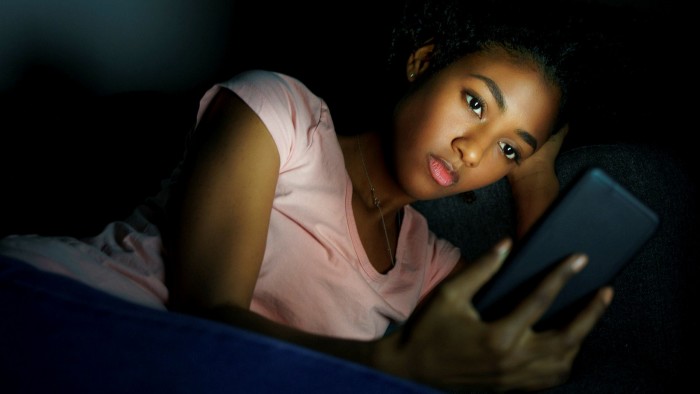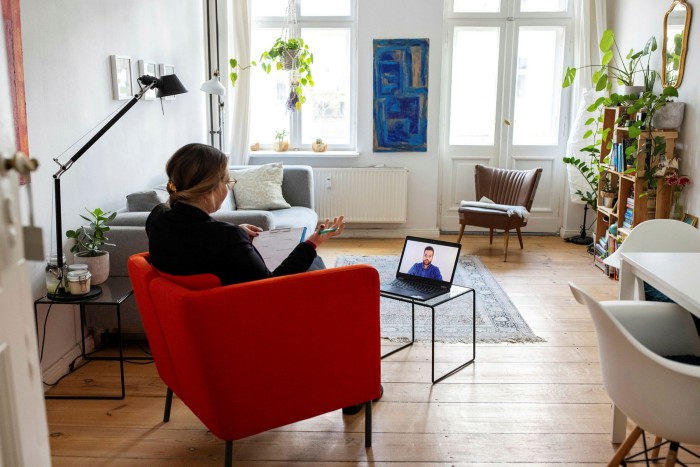The dark side of digital devices for children and how to beat it

Roula Khalaf, Editor of the FT, selects her favourite stories in this weekly newsletter.
When Facebook whistleblower Frances Haugen told the European Parliament in November that more should be done to prevent online harm, the welfare of children was among her concerns.
In highlighting the dangers of Instagram algorithms, such as posts on healthy foods that link to others that may encourage eating disorders, Haugen later told the FT that “kids die as a result of those things”.
Time spent on devices such as smartphones has risen during Covid-19 lockdowns, heightening concerns about young people’s use of technology, especially the negative impact of screen time on adolescent mental wellbeing. In 2019, a University of Oxford study failed to find a link, noting: “There is still little consensus as to whether and, if so, how digital-screen engagement affects psychological wellbeing.”
However, some experts argue that the real risks come not from screen time but the content and types of activities that it encourages. “If you use an iPad to do yoga for 20 minutes, that’s very different from scrolling through self-harm images,” says Amy Orben, co-author of the Oxford study and a researcher at the University of Cambridge.
Daniel Kardefelt-Winther of the UN Children’s Fund agrees. “If you look at specific experiences of children in the digital environment, that’s where you can find mental health impacts,” says Kardefelt-Winther, who leads Unicef’s Children and Digital Technologies research programme.

Social media exacerbates many of the problems. For young people, comparing themselves with peers or celebrities can contribute to increased stress and low self-esteem. In research by the Royal Society for Public Health (RSPH), young people in the UK said using four of the five most widely used social media platforms worsened their feelings of anxiety. “People only demonstrate their best side on social media,” says Merike Sisask, professor of social healthcare at Tallinn University in Estonia. “That can be stressful for children.”
To counter this, the RSPH recommends changes to social media platforms, including pop-up warning messages during heavy social media usage, disclosures indicating when photos of people have been digitally manipulated, and the teaching of safe social media in schools.
Regulators are starting to act. In the UK, the Age Appropriate Design Code prevents companies from tracking children’s locations, personalising content or advertising for them and creating behavioural nudges such as default autoplay on videos. But some researchers believe that psychologically damaging online experiences demand a more hybrid approach because they are related to abuse occurring in the physical world.
Cyber bullying is one example. Online, this kind of abuse can be perpetrated more easily. “The online world extends existing crimes or negative experiences,” says Kardefelt-Winther, who argues that cyber bullying can be more emotionally harmful than its offline equivalent. “You have no safe space,” he says. “You can be in your home on your phone and the bully can reach you.”

Instances of cyber aggression have risen as the pandemic has driven learning online. According to US and Israel-based L1ght, which uses artificial intelligence to detect and filter toxic online content away from children, hate between young people in online chats rose 70 per cent during lockdowns.
However, while digital technologies pose mental health risks to young people, they could also offer solutions. Digital phenotyping, for example, is a new technique for tracking online symptoms and behaviours related to mental illnesses in real time. Technology also offers the potential to expand access to mental health services in developing countries and low-income communities.
Nor do digital interventions need to be sophisticated. “People first think it refers to a fancy app that you need a smartphone to download, when often we’re talking about low technology, which is having a telephone that connects you to a therapist,” says Pamela Collins, professor of psychiatry and behavioural sciences at the University of Washington in Seattle.
“For some of the most neglected communities [in the US], simply getting public transportation to find a mental health provider can take a few hours. That’s no different in many countries where you have few providers and they’re not distributed evenly across the population.”
Collins says technology can help promote adolescent mental health in many ways, “from tele-psychiatry, or training people on a Zoom platform, to digital phenotyping, to people going to a website to have cognitive behavioural therapy”. But she adds that poor infrastructure in low-income areas hinders access. “To have a full Zoom session you [need] a data plan and adequate bandwidth,” she says.
Designs for digital interventions must take this into account, says Rebecca Braun, who leads the Youth Tech Health Initiative at California-based non-profit ETR. The initiative uses technology to promote young people’s health in Africa, Asia, Latin America and the US. “The first step, whether in the Bay Area or Honduras, is to understand what’s happening in young people’s lives — how they use technology, whether they have access to the internet and what’s important to them in terms of confidentiality and security,” she says. To enhance safety and security, many of the YTH Initiative projects enable users to create avatars for themselves, using any name, a gender-neutral identity and choosing race and ethnicity.
In Estonia, where 10-20 per cent of young people suffer from mental health problems and where the suicide rate for this age group is higher than the EU average, the impact of mobile apps is being evaluated. To test acceptance among young people, four apps — addressing self-harm, depression, suicidal thoughts and sleep patterns — were developed by AppsTerv, an Estonian project that, with funding from Norway, works to increase access to mental health services. “Young people loved these interventions,” says Tallinn University’s Sisask, who worked on the project. “We got feedback from mental health professionals that they used the apps between face-to-face sessions.”

Most apps, however, are developed by private companies, rather than non-profit groups or publicly funded ventures. This is a worry for Rachana Parikh, senior programme officer in the Indian office of Path, a Seattle-based non-profit health group. “In India, they are from foreign start-ups and largely target English-speaking audiences who can pay for access,” she says. “That’s not going to address problems for the majority of the country.”
Moreover, it is hard to know which digital mental health interventions are effective for young people. A recent review in the US by Columbia University’s Columbia Mailman School of Public Health and consultancy Spark Street Advisors found mixed evidence on the effectiveness of therapeutic video games, mobile apps and social networking sites.
In addition, says Nina Schwalbe, adjunct assistant professor of population and family health at Mailman, digital mental health interventions are part of a commercially driven market that is subject to little monitoring or regulation. She cites the example of a child using a chatbot to discuss suicidal feelings. “How does that become a referral? What kind of data is being collected and how does that affect future insurability?” she says. “It’s the Wild West out there.”

Comments